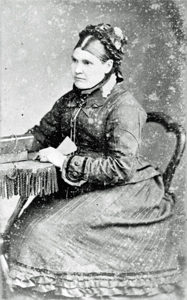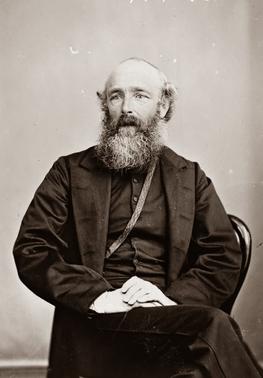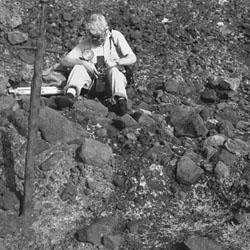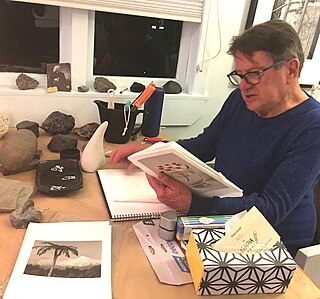Josiah Martin | |
|---|---|
 | |
| Born | 1 August 1843 London, England |
| Died | 29 September 1916 Auckland, New Zealand |
| Occupation | Photographer |
Josiah Martin (1 August 1843 - 29 September 1916) was a New Zealand teacher, photographer and prominent Auckland Freemason.
Josiah Martin | |
|---|---|
 | |
| Born | 1 August 1843 London, England |
| Died | 29 September 1916 Auckland, New Zealand |
| Occupation | Photographer |
Josiah Martin (1 August 1843 - 29 September 1916) was a New Zealand teacher, photographer and prominent Auckland Freemason.
Martin was born in London, England to mother Charlotte Bromley and father Josiah Martin. [1] Martin worked first in an insurance office, then as a coal merchant while in England. Then in 1864 married Caroline Mary Wakefield and in 1867 moved to New Zealand with their daughter. [1] [2]
Martin's first work experiences in New Zealand were in farming and operating a school in Northland region town, Maungaturoto. Martin was one of the founding members of the Grafton District School and remained headmaster there until 1874. [1] In 1875, Martin helped to set up the Auckland Model Training School, which was the first of its kind in Auckland. [3] He was also instrumental in founding the Auckland School Teachers Association in 1873 which aimed to create a national education program and fought for educational reform. [1]
In 1879 Martin was urged to retire from his teaching and headmaster roles due to poor health and changes in the education system. [2] He then turned his attentions to photography.

In 1879, he traveled to London and was introduced to rapid 'instantaneous' photography at the Royal College of Chemistry. [1] Once he returned to New Zealand, he opened a studio in Auckland. [1] Martin became well known for his topographical and ethnological photographs. He often presented these at the Auckland Photographic Club. [1] In 1886, Martin captured the eruption of Mt Tarawera on camera. [1] These photographs were published in the Auckland Evening Star . Martin has also been published in the Auckland Weekly News, [4] New Zealand Illustrated [5] and exhibited photographs at the Pitt Rivers Museum at the University of Oxford. [1] In 1886, he was part of the Colonial and Indian Exhibition and was awarded a gold medal in 1889 for his work in the Exposition Coloniale in Paris. [1] Martin's photographs appeared in the French illustrated press through the photo-agency Chusseau-Flaviens. [6]
Martin was an active lecturer, not only on photography matters but he also had an interest in geological and physiological subjects. [1] He was editor of Sharlands New Zealand Photographer and a founding member of the Auckland Society of Arts. [1] Martin served on the Auckland Institute Council from 1881 to 1892 and was the President of the Council in 1889. [7]
Martin died on 29 September 1916 at his Auckland home in Northcote at age 73.
An exert from his obituary in The New Zealand Herald reads:
Mr. Martin was a man of many parts, social, artistic, and scientific. In matters photographic he was one of the first men in New Zealand to exploit the scenic wealth of the country and his photographs of New Zealand panoramic beauty had great vogue some 30 years ago, long before the State formed a Tourist Department and took in hand the advertising of the special attractions of the country. Probably Mr. Martin's photographs did more to bring the Rotomahana Terraces and other thermal wonders of the Auckland Province under the notice of the world than any other medium. [8] New Zealand Herald, Volume LIII, Issue 16350, 3 October 1916
In 1958 his three daughters donated his collection of negatives to the Auckland Institute and Museum. [7] These collections have been displayed at Auckland War Memorial Museum such as in the 2024 exhibition, 'A Different Light- First Photographs of Aotearoa'. [9]
Te Papa, Auckland Art Gallery and the British Museum also house collections of Martin's photographic works. [2]

Anna Jacoba Westra, known as Ans Westra, was a Dutch-born New Zealand photographer, well known for her depictions of Māori life in the 20th century. Her prominence as an artist was amplified by her controversial 1964 children's book Washday at the Pa.
New Zealand photography first emerged in the mid-nineteenth century, and over time has become an important part of New Zealand art. A number of photography associations exist to support photographers in New Zealand.
John Brian Brake was a photographer from New Zealand. He is best known for his 1955 photographs of Pablo Picasso at a bullfight, his 1957 and 1959 series of China, and his 1960 Monsoon series of India.
Laurence Geoffrey Aberhart is a New Zealand photographer.

Theodorus Johannes Schoon was a Dutch-born New Zealand artist, photographer and carver.
Mark Adams is one of New Zealand's most distinguished photographers.

Thomas Andrew was a New Zealand photographer who lived in Samoa from 1891 until his death in 1939.

Elizabeth Pulman née Chadd was a British-born New Zealand photographer. She was regarded as being the country's first female professional photographer.

John Kinder was a British / New Zealand Anglican clergyman, teacher, artist and photographer.

Thelma Rene Kent was a New Zealand photographer.

Amy Merania Harper (1900–1998) was a New Zealand photographer. Harper was the first photographer in Auckland who used fluorescent lighting.
František Simon Hofmann, widely known as Frank Simon Hofmann was a Czech photographer who was recognised for his art in both Europe and New Zealand.

Eunice Harriett "Una" Garlick was a New Zealand photographer, known for her pictorialism style--a movement stressing photography's role as art. Her subject matter was mainly concerned with landscapes and Māori studies. Her most notable work is a series of portraits depicting Maori women.

Fiona Dorothy Pardington is a New Zealand artist, her principal medium being photography.

Adela Mary Younghusband, generally known as Adele Younghusband, was a New Zealand painter and photographer.

Olaf Petersen was a New Zealand photographer who specialised in nature photography. The main subject of his photos are the islands of the Hauraki Gulf and the beaches of West Auckland.

Peter Chanel Peryer was a New Zealand photographer. In 2000, he was one of the five inaugural laureates of the Arts Foundation of New Zealand.
Harriet Sophia Cobb was a New Zealand photographer. Her works are held in the collection of the Museum of New Zealand Te Papa Tongarewa. Cobb operated two successful photography studios in the late 1800s and into the 20th century.
Lloyd Godman is a photographer and ecological artist from New Zealand, now active in Australia. He uses living plants within his artworks and installations. His work is included in the permanent collections of Te Papa Museum, Christchurch Art Gallery, Auckland Art Gallery and the Dunedin Public Art Gallery.

Edith Amituanai is a New Zealand photographic artist. In 2007, she was the inaugural recipient of the Marti Friedlander Photographic Award. Examples of her work are held in the collections of Te Papa, Auckland Art Gallery, and the Govett-Brewster Art Gallery.
{{cite book}}: CS1 maint: location missing publisher (link)